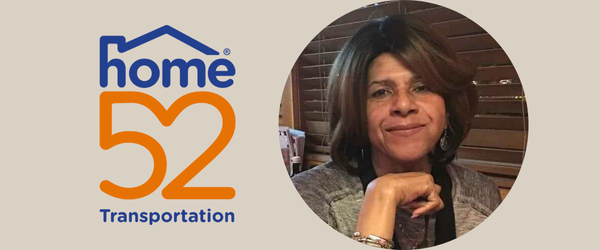Michelle Turnbow, 70, was a long-time user of public transportation. In recent years, she would take the bus to her volunteer position in the call center at St. Vincent de Paul; a position that gave her purpose, connected her with others and allowed her to get out of the house. Using public transportation, she could easily get to her doctor’s appointments, visit with friends at the senior center or go to the pharmacy to pick up her prescriptions.
Then Turnbow’s health took a turn, limiting her mobility and her ability to get to the bus stop. She had already been struggling with the effects of arthritis, which made it difficult for her to walk long distances. But then she began experiencing muscle pains in her legs as the result of a medication.
No longer able to walk to the bus stop, Turnbow had to rely on others for her transportation needs.
“I was feeling stuck and confined to my home,” Turnbow said. “I had to rely on my family and friends. Many had to take time off work to help transport me to doctor’s appointments. I was feeling isolated, sad and a burden to others.”
Turnbow is not alone. More than 11 million U.S. older adults are non-drivers and 2.3 million have transportation-related barriers that prevent them from participating in social activities, visiting with family and friends, and attending religious services. The 2019 Ohio Medicaid Assessment Survey found that 13.4% of older Ohioans who reported forgoing needed healthcare did so because of transportation-related issues.
“When we talk about older adults and transportation, it’s easy to understand the health impact of not being able to get to a doctor’s appointment or to the pharmacy to pick up prescriptions,” said Council on Aging CEO Suzanne Burke. “It’s the social and mental aspect that is often overlooked. If you think of the many ways we rely on transportation to help us stay connected to our social network, and then take away that transportation, the negative impact of that loss is significant.”
A study in the Journal of the American Geriatric Society noted that 40% of older adults said access to public transportation prevented them from using it. Common transportation access barriers for older adults include:
- Fewer routes in rural and suburban areas
- Cost
- Trouble understanding rideshare technology
- Rides that can’t accommodate mobility needs
- Poorly maintained sidewalks/routes to bus stops
- Weather
- Need for same-day or flexible scheduling
“We’ve long known older riders and riders with disabilities have unique transportation needs – needs that aren’t currently met through public access services or rideshare apps,” Burke said.
Turnbow connected with home52 Transportation, a specialized transportation service created by Council on Aging subsidiary, home52. home52 Transportation was designed with people like Turnbow in mind: individuals who need specialized or hands-on transportation service and who are not able to use public transportation or rideshare services due to their support needs or access barriers.
“This is exactly what I needed,” said Turnbow. “My prayers were answered.”
home52 Transportation understands the unique needs of older riders and riders with disabilities. The home52 Transportation Coordination Center contacts riders on the day of their scheduled trip with a reminder when the vehicle is on its way. This gives riders like Turnbow an opportunity to make sure they are ready to go and significantly reduces the time waiting for a ride to arrive. Riders can contact home52 Transportation when they need to schedule a ride – whether it’s a same day trip to the pharmacy or a future doctor’s appointment.
“[The transportation service] gave me my independence again,” Turnbow said. “It was easy to schedule my rides, and if something changed, I could easily cancel.” Turnbow said she appreciated the punctuality of the rides and the ability to have an open-ended trip. “Many times, I did not know my return time for a pick-up. I just needed to call them, and they would return in a timely manner to take me home.”
Many home52 Transportation providers are small, family- or minority- owned businesses. They provide hands-on, through-the-door assistance for riders, including help with any assistive devices riders may be using (walkers, canes, wheelchairs, etc.).
“I do love to talk,” Turnbow shared, adding that she appreciated the friendliness of the drivers, who, she said, were all willing to carry on a conversation with her.
For Turnbow, home52 Transportation offered her a renewed sense of independence and a chance to reconnect with her community.





